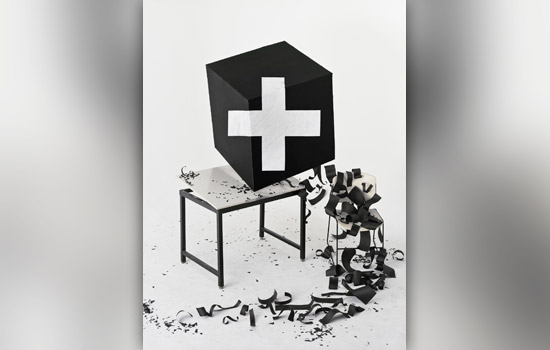Students win top honors in international contest
Students collaborated to produce and publish full-color magazine
Front cover of the RIT student-produced Positive/Negative magazine. The full-color magazine won top honors in the 2010 Photography Magazine Campaign or Series category sponsored by Creativity Awards.
A full-color, 100-page magazine created entirely by students in the Editorial Design course at Rochester Institute of Technology has won the Platinum Award at the 40th Annual Creativity Print and Packaging Competition.
The student-produced magazine, Positive/Negative, beat out entries from 31 countries to win the highest honors in the 2010 Photography Magazine Campaign or Series category. Creativity Awards sponsors the independent international advertising and graphic design competition.
The course, taught by Lorrie Frear, RIT graphic design professor, and Denis Defibaugh, RIT photography professor, allows the students eight weeks to produce all of the images, text and layouts for the magazine.
“It is a great collaboration between advertising photography students and graphic design students, where they learn about the skill sets and challenges faced by the other discipline,” says Frear.
As the winning entry, Positive/Negative magazine will be displayed on the Creativity Awards website and will receive a full-page treatment in the Creativity Annual Awards Book.
In past years, the student-submitted magazines received honors from Creativity Awards, but the 2010 entry marked the first time the students’ submission was voted best in this category.
The Editorial Design course is offered every winter and enrolls about 40 students.
“The class has gotten a sort of reputation,” says Defibaugh. “The students are excited because they know they are going to build something important to them.”
The course is designed to help students become more professional and understand the whole process of publishing a magazine.
Defibaugh says this process has come a long way because of new technology and digital output—evolving from a magazine spread project based on preexisting editorial content to a print magazine created entirely by students that they and donors can take home.
“At some point we will start planning to do an iPad version,” says Defibaugh. “Once we go to semesters, with 15 weeks to work on the magazine versus 10, that will definitely be possible.”
Frear and Defibaugh note the importance of the Platinum Award to RIT and the students who created the magazine.
“I hope that the students develop a greater respect and working relationship for each other, which is a good foundation for entering their respective and inter-related professions,” says Frear.
The current students enrolled in the Editorial Design course are in the final stages of production on their 2011 edition of the magazine.
Anyone interested in learning more about the project can contact Frear at lsfcad@rit.edu or Defibaugh at dldpph@rit.edu.














